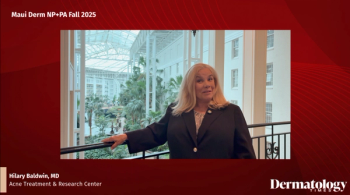
- Dermatology Times, October 2020 (Vol. 41, No. 10)
- Volume 41
- Issue 10
PDL, botulinumtoxinA improves rosacea symptoms
Treatment with a pulsed dye laser followed immediately by intradermal botulinumtoxinA injections appears safe and improved erythema, flushing, burning and pruritus, according to a recent study.
A combination approach using a pulsed dye laser (PDL) and intradermal injection of botulinum toxin-type A (BoNTA) is safe and effectively improves erythema and disease-related symptoms, says Firas Al-Niaimi, M.D., who, with colleagues, summarized experience using this approach in a series of 20 patients with moderate-to-severe erythema and flushing.1
“As with any treatment, there was variability in the magnitude of response. Overall, however, all patients benefited, and the patient satisfaction rate was high,” he tells Dermatology Times. Dr. Al-Niaimi is a senior consultant dermatologist in London, UK.
Discussing the basis for combining PDL and intradermal BoNTA, he notes the limitations of PDL, which is a standard treatment for erythema and telangiectasia, and the potential for synergism with BoNTA.
“PDL can improve erythema by addressing the vascular component of inflammation, and by reducing Demodex density, it can modulate the innate immune system to reduce burning and pruritus. However, PDL treatment has a somewhat limited effect on flushing,” Dr. Al-Niaimi explains. “By targeting neurogenic inflammation, BoNTA is particularly good for relieving bothersome flushing as well as pain and burning.”
The patients were treated at three different centers with the same protocol over an 18-month period and seen for follow-up after three and nine months. Other than appropriate skincare products, they did not use any topical or systemic therapies for rosacea management. Patients received a series of three treatments performed every four to six weeks. The same PDL was used at all centers (VBeam, Candela). A single pass at sub-purpuric settings was performed, but the specific laser parameters were adjusted based on each patient’s skin type, amount of chromophore, skin response and anatomic area. Spot size ranged from 7 to 10 mm, pulse duration was set at three, six, or 10 ms, and fluence ranged from 7 to 10 J/cm2. The intradermal BoNTA injections were administered immediately after the PDL treatment. Ten patients were treated with abobotulinumtoxinA (Dysport, Ipsen) and the others received onabotulinumtoxinA (Botox, Allergan). AbobotulinumtoxinA was reconstituted to achieve a final concentration of 100 units/ mL and onabotulinumtoxinA was reconstituted to achieve a final concentration of 40 units/mL. Injections were delivered only in the area of the cheeks affected by flushing and were performed using a 30-gauge needle with spacing at 1-cm intervals. The total dose was individualized taking into account flushing severity and area.
The efficacy of the treatment for improving erythema was objectively quantified through analysis of spectral uptake on digital images acquired using a 3D camera system (Antera 3D camera, Miravex Limited) and graded subjectively by the treating dermatologists using the six-point Clinician’s Erythema Assessment Grading Scale.
Patients benefited with a discernable reduction in erythema and episodes and severity of flushing lasting several months. Improvements in burning and pruritus were maintained at the nine-month follow-up visit. The reduction in flushing was relatively durable, and although it began to wane as the effect of the BoNTA dissipated, patients maintained improvement compared with baseline. The investigators suggested the benefit may be attributed to laser-induced eradication of vessels involved in flushing.
“Although it has been suggested that abobotulinumtoxinA has a longer duration of action than onaBoNTA, we did not observe any difference between the two products with respect to peak benefit or longevity in our small series of patients,” Dr. Al-Niaimi says.
Side effects were generally limited to expected sequelae of the PDL treatment. A single patient developed mild purpura that resolved after 10 days.
The article presents the outcomes achieved in a small cohort of patients who were selected because they were treated with a standardized protocol and followed prospectively. However, Dr. Al-Niaimi says they have used the combination in a much larger number of patients with equally good results and consider it a valuable treatment option for patients with concomitant flushing and fluctuating erythema.
Disclosure: Dr. Al-Niaimi has no relevant financial interests to disclose.
Reference:
1. Al-Niaimi F, Glagoleva E, Araviiskaia E. Dermatol Ther. 2020. Published online ahead of print, July 7, 2020. doi: 10.1111/dth.13976.
Articles in this issue
about 5 years ago
Stem cell media boosts microneedling benefitsabout 5 years ago
Cosmetic procedure complications in darker skinabout 5 years ago
My experience with surface radiotherapyabout 5 years ago
Trial compares NMSC destructive techniquesabout 5 years ago
Phenotype-based approach advances managementabout 5 years ago
Misinformation delays rosacea diagnosis in skin of color patientsabout 5 years ago
The retinoid revolutionabout 5 years ago
Managing pandemic patient volumesabout 5 years ago
I warned my patient – was it enough?about 5 years ago
Dupilumab outlasts cyclosporineNewsletter
Like what you’re reading? Subscribe to Dermatology Times for weekly updates on therapies, innovations, and real-world practice tips.


















